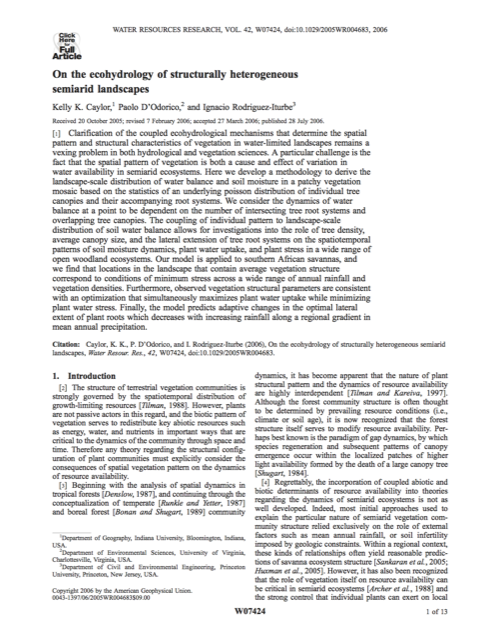On the ecohydrological organization of spatially heterogeneous semi-arid landscapes

Caylor, K.K., P. D’Odorico, I. Rodriguez-Iturbe (2006) “On the ecohydrological organization of spatially heterogeneous semi-arid landscapes.” Water Resources Research, 42(7), W07424, doi:10.1029/ 2005WR004683.
Clarification of the coupled ecohydrological mechanisms that determine the spatial pattern and structural characteristics of vegetation in water-limited landscapes remains a vexing problem in both hydrological and vegetation sciences. A particular challenge is the fact that the spatial pattern of vegetation is both a cause and effect of variation in water availability in semiarid ecosystems.
Here we develop a methodology to derive the landscape- scale distribution of water balance and soil moisture in a patchy vegetation mosaic based on the statistics of an underlying poisson distribution of individual tree canopies and their accompanying root systems. We consider the dynamics of water balance at a point to be dependent on the number of intersecting tree root systems and overlapping tree canopies. The coupling of individual pattern to landscape- scale distribution of soil water balance allows for investigations into the role of tree density, average canopy size, and the lateral extension of tree root systems on the spatiotemporal patterns of soil moisture dynamics, plant water uptake, and plant stress in a wide range of open woodland ecosystems.
Our model is applied to southern African savannas, and we find that locations in the landscape that contain average vegetation structure correspond to conditions of minimum stress across a wide range of annual rainfall and vegetation densities. Furthermore, observed vegetation structural parameters are consistent with an optimization that simultaneously maximizes plant water uptake while minimizing plant water stress. Finally, the model predicts adaptive changes in the optimal lateral extent of plant roots which decreases with increasing rainfall along a regional gradient in mean annual precipitation.
